|
| Exploring the right and left brain... and how they interact across various tasks |
I am personally and professionally interested in human creativity. My current focus is on how the right (intuitive, associative) brain works--or doesn't work--with the left (analytic, rational) brain. My experience in art and advertising has led me to believe that the left brain and the right brain (as well as right-brain people and left-brain people) don't always work or play together very well--at least for those of us who aren't Leonardo da Vinci. One of my goals is to help myself and others learn how to get the left and right brains to dance together--more efficiently and elegantly--for the greater glory and benefit of both.
Although self-introspection has its limitations (especially as a science), I have recently been giving myself artistic (and scientific) tasks to perform so I can try to develop a better feel and understanding of how my right and left brain interact in various situations. The example I am presenting here--a simple wire and stick sculpture--gave me a good opportunity to observe this interaction. The sculpture and the narrative attempting to capture how my right and left brains worked together on this task are presented below. |
| Wire and stick sculpture #1 a predominantly right-brain project |
|
Object I made in my backyard, 3 September 2007. Wooden sticks from tree branches and black bailing wire. |
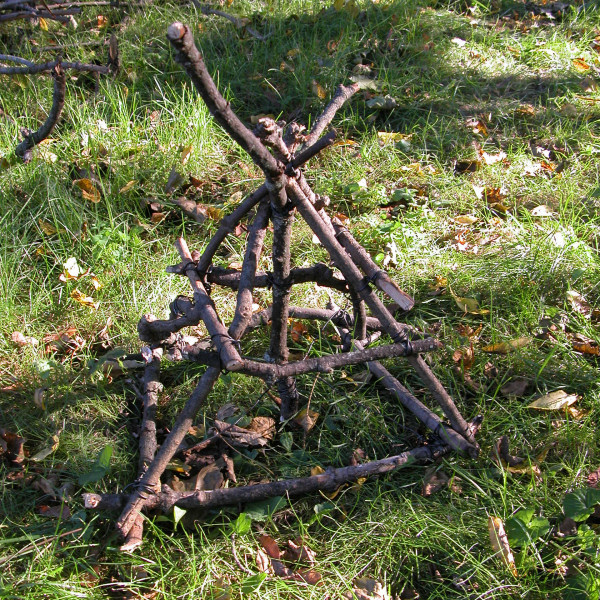
|
| Approximately 15-inches square at base and rising to pyramid point 12-inches high. A fork in one stick extends above the pyramid point to give the object a total height of 18-inches. |
|
The following post-hoc conversational script illustrates some of the back and forth and the give and take I sensed between my left and right brains as I created the wire and stick sculpture: | |
| 1. Initiating the artistic task | |
| Late on the afternoon of a holiday. I've just finished up one of my planned tasks and am thinking about what to do next... | |
| Right-brain: Let's take this opportunity to start working on that project I've been kicking around. | I am not really sure who--between the right & left brains--initiated this project, but the desire and idea to create something artistic with sticks and wire came out of some work I was doing for my wife recently--helping her wire together long branches into "stick walls." |
| Left-brain: What are we going to do? | Left brain is always eager to query these projects--to start asking for details and explanations. It's not so much that my left brain is skeptical or negative about these artistic projects, so much as it wants to help. It believes the right brain needs its practical, linear help. Under the guise of helping, the left brain seems to seek to take over and "lead" the project. To make sure the project will have some "meaning" and seriousness behind it. Give it parameters that will make it "realistic." |
| RB: Something cool and arty with sticks and wire. | My right brain doesn't seem to like being questioned by my left brain (or it doesn't like communicating with my left brain on its terms). So my right brain gives cryptic answers. |
| LB: Like what? What's your idea? | Left brain keeps trying to get more information/details it can sink its analytic teeth into. |
| RB: I've got a couple of ideas. Don't worry, we'll work something out. | Tries bluffing the left brain with a bit of confidence. The right brain has come to this task without a strong vision or organizing idea of what it wants its first object in this new playing field to look like or accomplish. Right brains trusts itself to find something--to start playing around and developing some ideas. |
| LB: Well, if you don't have any ideas, I do. We could build a square, a box, or some three-dimensional geometrical shape. That should be pretty easy. I know how to take sticks and wire and build something. | My left brain approaches this from a task orientation: goal is to build something with these pieces. Geometric shapes are basic building blocks--simple "plans" the left brain can work with. |
| RB: Well......okay. I suppose we could start with that idea. RB to self: (We're going to need a cooler idea than that.) RB: Why don't you go get the tools. |
My right brain is now starting to feel a little pressure from the left brain. It's played this game before and is going to go with Plan X: let the left brain start with its functional orientation and then intervene as necessary to keep this project on an artistic track. |
| LB to self: (Got materials we can work with? Check. And we know how to build things. Double check). | The right brain's response ("go get the tools") sends the left brain into action and leader mode. |
| 2. Starting to work with the sticks and wires | |
| I sit down on the grass in my back yard near a pile of sticks that are about three to four feet long. I've brought two types of pliers and a spool of black steel wire (heavily oiled to protect it from rusting before use). The initial idea going in is to build some sort of pyramid or teepee-like structure. | |
| RB: Let's look at what we've got and pick a few branches to start. | I pick through several different piles of branches while the right brain watches for one to select. The right brain is sizing up what we've got to work with. Different branches from different trees, with different barks, and bends, and bumps, and colors...many fallen branches that have already lost some of their strength and weight. |
| LB: We need strong branches...that won't break when we're wrapping and tightening the wire around them. Let's start with some fairly straight branches for the base. | I continue looking through the stick piles. |
| RB: Ah, this is a nice stick. Only it's too long. Let's break it off. | The right brain is more interested that the sticks look good and have some character...it doesn't ask the left brain if they're straight enough. |
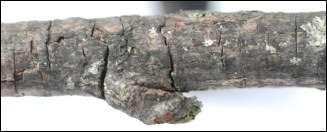 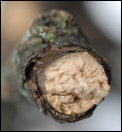 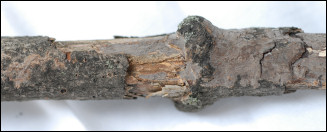 | |
| LB: I see that you like this stick because it's craggy, but are you sure that it's strong enough? A lot of these sticks look too thin...like they might easily break. Why don't we pick out some more sticks and start to set up the base of the structure...to get a better idea of how we're going to do this and what types of sticks to use. |
The right brain tacitly agrees to avoid sticks that the left brain thinks are "too thin"...because that still leaves a lot of sticks to choose from. |
| RB: Okay, here's a couple more sticks I like. We can break them off until they are about the right length. | The right brain spends some time turning the sticks around and trying to figure out where to break them (e.g., above or below this knob or that bend)...and what a "good break" would look like (e.g., not too clean, not cut, more like a rough snap). |
| LB: Okay, let's lay out the base. Hmmm. We were thinking of making the base of this sculpture square...but we could do it as a triangle, too. [Goes back and forth between arranging three- and four-stick layout. I don't know, we could do it either way. Which do you like best? | The left brain knows it relies on the right brain to make these sort of aesthetic/artistic decisions...but likes to pose as being a generous or benevolent leader while it does this. |
| RB [while rearranging sticks and turning them over and around to examine their ends and their sides and while continuing to look at the nearby stick piles for other candidates.]: Let's go with the four-sided bottom. | Right brain looks and waits for inspiration to bubble up to help it make the decision. When that doesn't happen, the right brain decides to go with square base instead of triangular base...mostly because four-sided sculpture will start with more sticks...more to work with...more possibilities. |
| LB: Okay, let's start. | The left brain likes the idea of the four-sided base--sturdier and more stable than a triangle base. |
| I cut a short length of bailing wire, pick up the right brain's favorite stick, and start wrapping one end of it with the wire. When I try to pull the wire tight with some pliers, the stick breaks in my hand. It was more rotten than I realized. | |
| LB: See. I told ya. The sticks have to be strong enough to take a lot of manipulation and torque. | I start squeezing and test-bending our other sticks candidates. They all seem pretty strong. Stronger than the broken stick, anyway. |
| RB: Fine. That one was more rotten than we realized. Look, there are plenty of other good sticks here. Let's start, again, with this one. | I pick up a stick and fit it into the previously made loop of wire, and carefully tighten it up around the end of the stick. Doesn't break this time. |
| LB: Okay, good. Now let's attach it to a second stick. | Left brain picks up a second stick from the layout and begins to wrap the wire around the cross-over end of that stick. The left brain is concerned to wrap the wire and to bind the two sticks together in a way that is structurally sound and smart. The right brain wants there to be some variation and style in how this is done. Wants a more handmade, homemade, "arty" look than a consistent "professional" manufactured look. Mediating both brain's desires is the difficulty of easily bending the bailing wire--especially to make a tight bend, wrapping one wire around another or when twisting two ends together to complete the binding. My right and left brains had already been through this back-and-forth during the project where I wired my wife's branch wall-panels together. We had already developed a craft and a set of different ways to wrap sticks with this bailing wire--so the right and left brains already had a good feel for the territory we were working in. |
| RB (with a sudden idea): Let's add a stick as a center pole in this pyramid...something that will stick out at the top. Hmmm...maybe something that has forking branches at the top. | I stop to look for a stick with a branching fork. I find one and size up the height where it should branch out...before breaking it to fit this height. |
| LB: Okay, let's finish the base...and then add the center pole. | The left brain wants to finish the immediate task: building the square base. The right brain is less linear and likes to skip around...sometimes jumping several steps ahead. The left brain acts as if it has been assigned the responsibility to keep the project on track and proceeding in an orderly fashion. The left brain wants to get the project done and done right. The right brain wants to feel its way along, find some enjoyable inspiration, and make the sculpture something cool. |
| I finish the base by joining four sticks together to make a rough square (more like a rectangle). Then I add the center poll by first wrapping a long piece of wire around its base and then using the remaining wire to anchor it to opposite corners of the base. | |
| 3. Thoughts along the way | |
| After wiring the center pole to the base of the sculpture, I proceed to add the four basic sides (the new sticks that are wired to each corner and that raise to meet the center pole at the "peak" of the pyramid. This involves a continuous give and take between the right and left brain over the "best sticks" for the job and the "best way to wrap and affix the wire bindings." The right brain increasingly prefers bent and knobby sticks and loopy and crude wire wrappings. My left brain actually seems to like the various challenging sticks and the "let's do the next one differently" wire wraps/bindings the right brain chooses--it's a way for the left brain to show off and demonstrate its building ability and skills on this predominantly right-brain task. | |
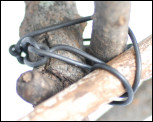 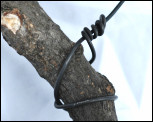 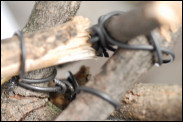 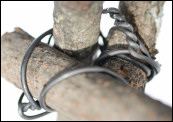 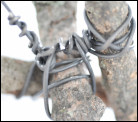 | |
| LB (repeated many times during the project): Let's do this and then that. | As this project begins to move along, my left brain also focuses on the order in which things are are to be done. It develops its own sense or plan for how activities and steps in the building process should be logically sequenced. Logically sequenced encompasses at least two considerations: the pieces should be added in a logical order (e.g., don't want to have to add some stick only to later have to try to remove it because it is now blocking some other planned piece from being added) and 2. the object should be well constructed (e.g., sturdy enough, stable enough in its orientation, etc.) in terms of its use and functionality--in this case to sit on a table or shelf and look "artistic." |
| RB (repeated many times during the project): Let's do it this way. | In general my right brain seems to be concerned with how something is going to look or appear to "the viewer" more than (or as long as) it meets the left-brain's minimum practical and functional requirements The dance between my left and right brain seems to go something like this: My left brain decides "let's add this piece here." Right brain often goes along with the "steps" or sequence taken by the left brain, but focuses on the orientation and shape of the stick and the wire binding in and of itself and also in relationship to the current object and its overall look. My left brain may try to "help out" with this decision-making by pointing out some functional or practical reason why one choice is better than another. This stick-and-wire sculpture has such minimal practical and functional requirements, however, that the right brain is in the driver's seat on this task--the left-brain is there to try to figure out how to execute the right brain's aesthetic choices. It is not always clear to my right brain, however, which of various possible stick orientations, positions, binding options would be the "most" aesthetically pleasing (i.e., have the "coolest effect). My right brain is often indecisive in making these choices...it often feels like an aesthetic decision--no matter how minor--will have a serious impact on aesthetic success of the whole project. The right brain is more likely to stall around (waiting for some inspiration or feeling to bubble up and help it decide) than to just make a quick arbitrary decision. The left brain is always lurking, however, ready to push on and lead...to get the project done. Sometimes its argument that "either way is equally good, so it doesn't really matter which way we do it, let's do it this way" works and can even be a welcome rescue for my right brain. |
| After completing the basic four-sided three-dimensional pyramid (or teepee structure), I was pretty pleased. This sculpture looks primitive-arty, stick-craggy, and cool, and will probably look even cooler when the wire bindings rust from black to a lighter (and more visible) orange-brown. But it didn't feel like the sculpture was really done (especially to the right brain)--it seemed too "empty" or "vacant" or simple. | |
| RB: There's too much open space on each pyramid side. Let's add some more sticks --inside or across the outside...or something. | This is a pretty clear and easy aesthetic judgment for the right brain. |
| LB: Okay. How about fastening four sticks around the middle of the sculpture...halfway up each side? | My left brain's natural inclination as a logical builder is to put straight sticks across each side of the pyramid... level, symmetric, sturdy. |
| RB: That's too even and uniform...but let's start playing around with that idea and vary it from there. Let's use some really bent sticks...and explore hanging them tilted and at different heights. | My right brain didn't have an immediate alternative idea so it decided to work with my left brain's suggestion. Again, this turned into a moderately compatible dance between my right and left brains...my right brain choosing cool sticks and trying them out in different positions on the pyramid...with my left brain happy to take on these construction challenges--still seeking to make each new stick's position on the pyramid contribute (at least nominally) to the stability of the structure. The right brain also pushed for more "interesting" "overdone" looking wire bindings for these four sideways sticks, and the left brain was happy to comply with this challenge, too. |
| One other repetitive building task and aesthetic task through which my right and left brains danced is also worth noting: the pieces of wire used to wrap around and bind two pieces of wood to each other were finished by twisting their ends together into three or four or more tight loops and then cutting off the excess with some sturdy wire cutters (on the side of the square-headed parallel pliers I was using). The final several twists were usually performed using a pair of pliers--this allowed me to cinch up the wire more tightly to the wood and bind the two pieces of wood together more tightly. A very functional, practical task in building a good and sturdy object. Almost everytime this task prompted a dance between my right and left brains...over the final positioning and appearance of these twisted end wires. | |
| LB: These twisted wire endings are a little dangerous. They could cut or puncture someone sticking out like that. Let's bend these wire ends back or tuck them away so they aren't sticking out. | The left brain has a practical concern that its construction be safe. |
| RB: Okay. | The right brain doesn't have a strong reason to like these twisted ends sticking out so it's easy for it to go along with this safety measure. |
| LB: This isn't as easy as I thought it would be. | I've discovered that these little twisted endings are sturdy and short, making them difficult to bend very far. In addition, the corners and angles where these ends are don't provide a lot of room for manuevering...even with my needle-nosed pliers. Developing a new technique or new skills for solving a new construction problem is the kind of challenge my left brain likes. |
| RB: Why don't you tuck that one away a little more? | My right brain starts to get concerned about how these various sort-of-bent-back ends are looking. To the right brain many of these unnatural, manipulated bends are looking both "half-assed" and aesthetically unappealing. There are not a lot of good options for what can be done with these short stiff ends, so the left and right brain give up on the idea of finding a really satisfactory solution and just do "the best they can" under the circumstances (i.e., lower their construction/safety standards and aesthetic standards, respectively). |
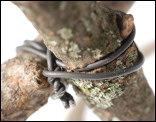 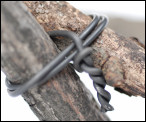 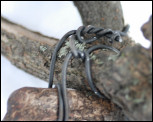 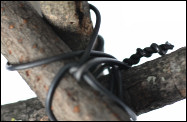 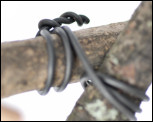 | |
| 4. Thoughts while finishing the sculpture | |
| A great challenge facing the brain in an open-ended task like this is deciding when the project is done. This is especially true in this case since we were not guided by a strong or clear vision of what we wanted our final sculpture to look like -- more of a let's-build-it-and-see-where-it-goes attitude. In some cases, a clear vision or "end image" emerges (from the right brain) during the course of the project. But not in this case. | |
| LB (looking at the sculpture after the last sideways stick is attached and most of the wire ends have been bent back): Are we done? | The left brain has helped the right brain build a sound, interesting looking object and doesn't need to do anything more to feel satisfied and completed. It's ready to call the building process a success. |
| RB (as I pick up and hold the sculpture at different angles): I don't know. Maybe we should add more sticks...fill it in a little. Seems like it needs...more...something. | The right brain likes the sculpture as it is right now but also wonders if it would be better to push on and add some stuff. The right brain also knows from previous experience that it is easy to go "too far" with these projects. Right brain is worried about stopping too soon as well as about going overboard. |
| LB: This center post may keep it from resting squarely on the bottom...we may have to break off some of it. | While the right brain is stuck trying to make the "are we done or not" decision, the left brain distracts it with another concern. |
| I've been building this sculpture sitting on my butt in the grass in my back yard--not a perfectly flat or even surface. It looks like the center-pole stick sticks down below the base of the sculpture. If this is true, then the sculpture will not sit perfectly flat and stable on its base. It's sitting flat and stable enough on the bumpy ground and grass, but that doesn't mean it will on a flat surface. | |
| LB: Let's go ahead an break a little off the bottom of the center post, just to be safe. | Left brain takes preemptive action. I take the pliers and carefully break off just a little bit of the bottom of the stick. |
| RB: Let's not break off too much. Let's break it so it looks okay." | As with most of operations performed with my hands on this project, the right brain monitors and advises with a watchful eye. |
| I pick up the sculpture, stand up, drape my t-shirt over it before taking it up on the deck and unveiling it before my wife, Janice. I present it to her as a present. She starts exclaiming and I mumble something like "The first one is always the best one, you know" and go into the house to wash all the greasy wire oil off my hands. I come back out. Look at the sculpture and start to fuss at it a little, saying to Janice "I'm not sure that it's done." "Seems kind of empty here and here," while pointing to several places). "Maybe I should add some more sticks there..." | |
| Caveats and end notes.
Of course my left and right brains do not actually "speak" or talk like I have described above. What I have tried to do is personify through conversation the ideas, views, and concerns that each side of my brain brought to the task of building this stick and wire sculpture. I have tried to capture and honestly present what I think I was experiencing in my mind as I worked through this project, but I may be wrong--introspection into non-conscious and even conscious events is an iffy process for getting reliable information. But it seems like a good place for me (and maybe you) to start. I intend to repeat this same introspective exercise with several other tasks that vary in the degree to which they are predominantly left or right brain tasks, as well as with tasks that require a fairly constant working relationship between the right and left brains vs. tasks where what the right and left brain do can be separated and "compartmentalized." After producing a set of post hoc right- and left-brain narratives for each of these tasks, I hope to be able to draw some conclusions and learnings that will help me to develop more sophisticated and comprehensive ideas (speculations and maybe theories) about the various ways that the right and left brain work and play--dance--together. In turn, I hope this will help lead me to exercises and activities that I and others can use to turn this sometimes faltering dance into a more elegant and exciting tango. |
| And now...a little goofing around: I posted this picture, with the caption "Device for exploring the right and left brains" at fluxflist.blogspot.com--one of my favorite playgrounds. |
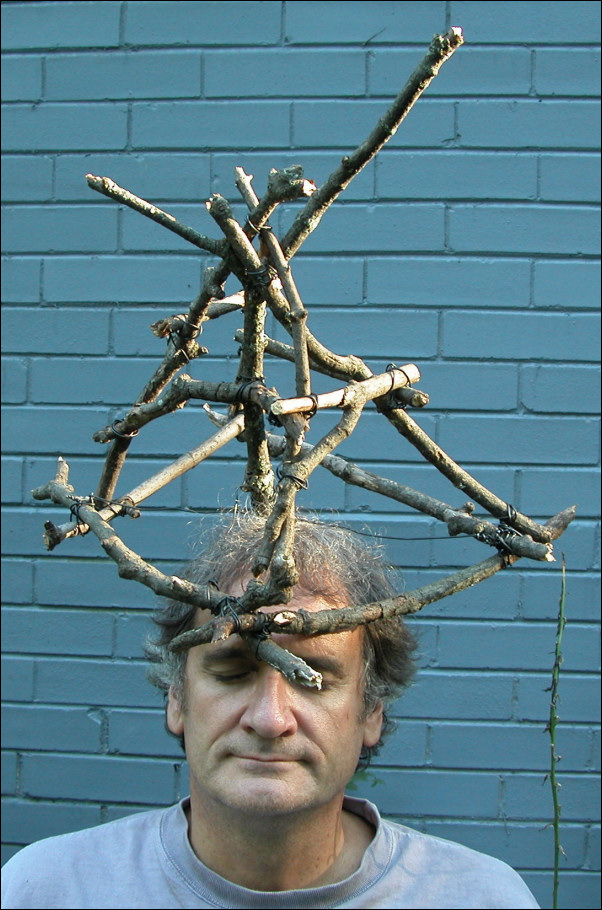
|
 |
 |
| © 2007 Allen Bukoff & WorkingCreativity.com | |


